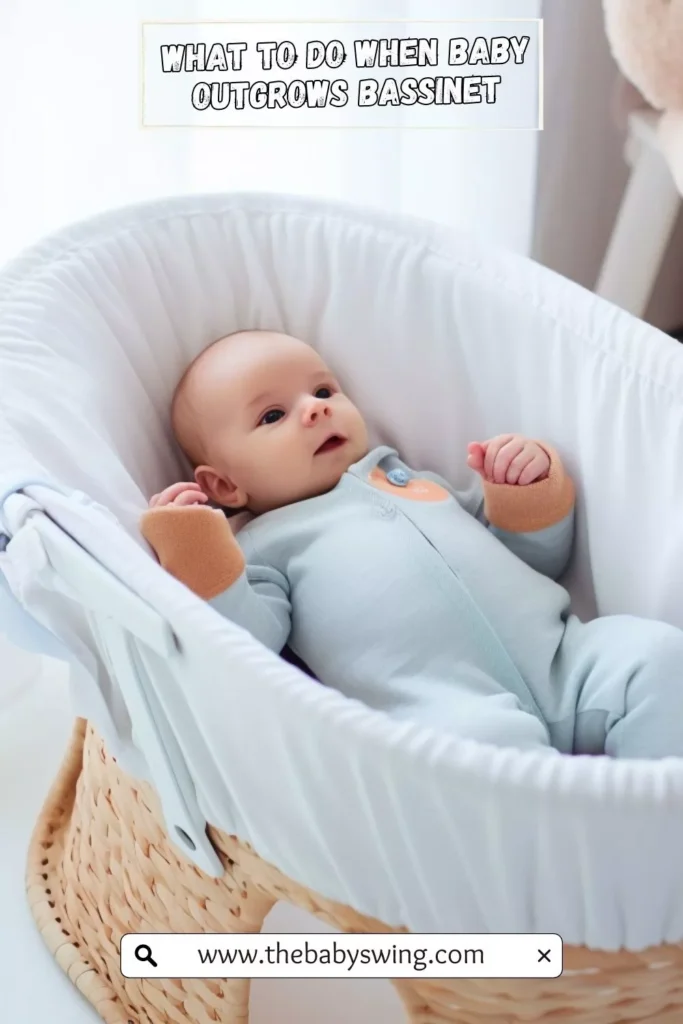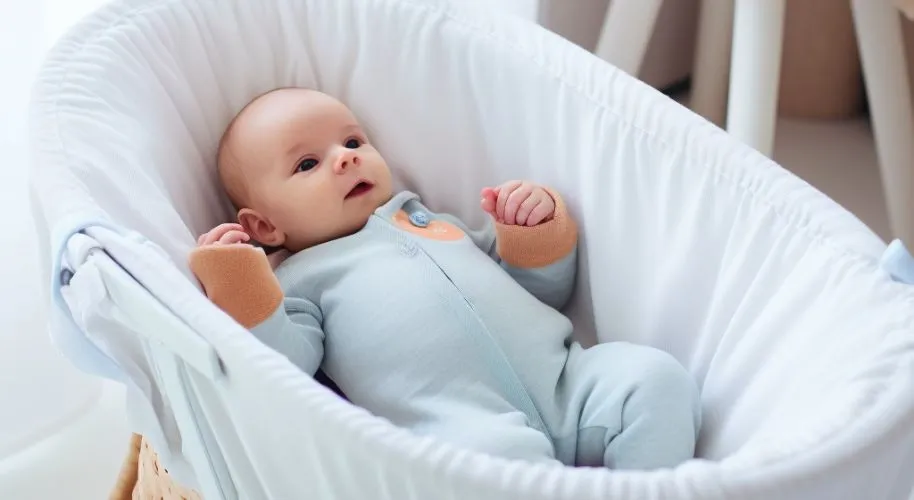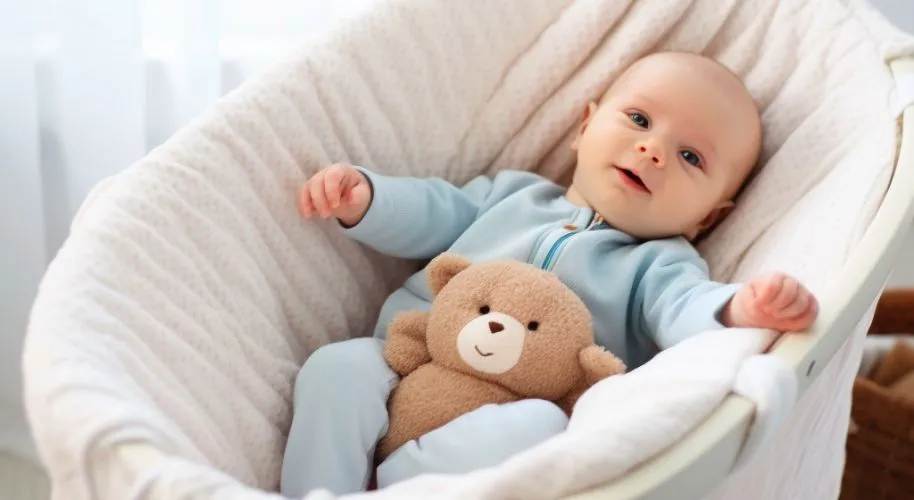Last Updated on June 5, 2025
Navigating the journey of parenthood often comes with a myriad of questions, one of which is, “What do I do when my baby outgrows their bassinet?” This is a common query as babies typically outgrow their bassinets between 4 to 6 months of age.
The next step, usually, is transitioning your little one to a crib for their safety and comfort. It’s crucial to watch out for signs that indicate it’s time for the move, such as your baby exceeding the bassinet’s weight limit or showing signs of discomfort.
Other options include using a bedside sleeper or co-sleeping for a transitional period. For further interesting knowledge, continue your reading.

What can be done when a baby outgrows a bassinet?
When a baby outgrows their bassinet, typically between 4-6 months, it’s time to consider transitioning to a crib or other safe sleeping options. If your baby isn’t ready for a full-sized crib yet, there are several strategies you can employ.
One approach is introducing frequent day naps in the crib, allowing your baby to acclimate gradually. Placing the crib next to your bed helps ease the transition, providing them with a familiar environment and more space.
Creating a safe and comfortable space is crucial. Ensure that the crib adheres to safety standards, has a firm mattress, and is free from loose bedding and soft toys. Setting a consistent sleep cycle can also provide stability and predictability.
Bedside sleepers could be an option for families who prefer to keep their babies close. Babies usually outgrow these around the same time as bassinets. Another alternative is bedsharing, then transitioning to a crib like a co-sleeper.
If the bassinet’s mattress is too small, you can buy a foam topper to make it bigger. But if your baby is rolling over or showing signs of discomfort, switch to a bigger bassinet or directly to a crib.
How do you know when a baby has outgrown a bassinet?
Knowing when a baby has outgrown a bassinet can be determined by several key indicators. Here are some points to consider:
- Weight Limit:
Most bassinets have a weight limit, typically around 15-20 pounds. According to the American Academy of Pediatrics, If your baby is nearing or has exceeded this limit, it’s a clear sign they’ve outgrown the bassinet.
- Height Limit:
Bassinets also have a height limit. If your baby’s head or feet are touching the ends of the bassinet, or they look cramped, it’s time for a larger sleep space.
- Mobility:
Once babies roll over, sit up, or push up on their hands and knees, it becomes unsafe to remain in a bassinet. These actions could cause the bassinet to tip over or the baby to fall out.
- Discomfort:
If your baby seems restless, uncomfortable or wakes up frequently, it could be because they don’t have enough space to move around comfortably.
- Outgrowing the Sleep Surface:
If the surface area of the bassinet seems too small for your baby to stretch out or roll over slightly, they’ve likely outgrown it.
- Age:
Typically, babies outgrow their bassinet by 4-6 months of age. However, every baby is different, so this can vary.
When should a baby transition from a bassinet to a crib?

The transition from a bassinet to a crib usually occurs when a baby is between 3-6 months of age.it’s important to remember that every baby is unique, and the transition should be based on individual development and comfort.
According to AAP guidelines, keeping your baby in your room until 6-12 months can reduce the risk of SIDS. Nevertheless, most babies outgrow their bassinet between 3 and 6 months, as each has a weight or length limit.
“Most babies should transition from the bassinet by 4 – 6 months of age due to safety concerns and comfort,” says our expert. The key here is safety. When babies roll over, sit up, or show discomfort, it’s time to move them to a more secure environment.
You Might also Like These Resources !
What should a baby sleep in after outgrowing a bassinet?
When a baby outgrows their bassinet, generally between 3-6 months, parents have several options for where the baby should sleep next.
- Full-size Crib:
This is the most common choice. However, ensuring the crib meets safety standards and is free from loose bedding and soft toys is crucial.
- Mini Crib:
A mini crib could be a good option if space is an issue. It’s smaller than a full-sized crib but provides more room than a bassinet.
- Pack-n-Play:
These portable play yards can also serve as a sleeping area. They offer more space and are easy to move around or travel with.
- Bedside Sleeper:
Some families opt for a bedside sleeper, but most babies outgrow these around the same time as bassinets.
- Bedsharing:
Some parents choose to share their bed with the baby, followed by a transition to a crib set up like a co-sleeper.
- Sleep Sack:
If you’ve been swaddling your baby, transitioning to a sleep sack could be a safe option to keep your baby warm but free from loose blankets.
How can a baby be transitioned from a bassinet to a crib?

Transitioning a baby from a bassinet to a crib can be a significant change for both parents and the baby. Here are some steps to make the transition smoother:
- Start Gradually:
Begin by having your baby take their daytime naps in the crib to get them used to the new environment.
- Familiarize the Baby with the Crib:
Let your baby have some supervised playtime in the crib during the day so it becomes a familiar place.
- Maintain Bedtime Routines:
Keep the same bedtime routine during the transition. This could include bath time, reading a book, or singing a lullaby before bed.
- Make the Crib Comfortable:
Use the same sheets from the bassinet in the crib for a while. The familiar smell can help your baby adjust.
- Room Sharing:
Move the crib into your room initially. This can make the transition more manageable for your baby.
- Provide Reassurance:
If your baby wakes up upset, offer comfort but try to avoid picking them up. Patting their back or a gentle shush can provide reassurance.
- Be Patient:
Expect some resistance and know that it might take time. Every baby is different, so what works for one might not work for another.
What can be done if a baby refuses to sleep in a crib?
If your baby refuses to sleep in a crib, here are some strategies you can try:
- Gradual Transition:
Start by introducing the crib during nap times to help them get used to the new environment.
- Comfort Items:
Incorporate a familiar item like a blanket or toy your baby associates with sleep and comfort.
- Consistent Bedtime Routine:
Maintain a regular bedtime routine to signal your baby that it’s time to sleep.
- Soothing Sounds:
Use white noise or soft lullabies to create a calming atmosphere.
- Room Darkening:
Ensure the room is dark enough to promote sleep.
- Patience:
It may take time for your baby to adjust to the crib. Be patient and consistent.
What developmental milestones make bassinets unsafe for babies?
Bassinets become unsafe for babies when they start reaching certain developmental milestones. One of the key milestones is the ability to roll over, which typically occurs around the 6th month, but some babies can start rolling as early as 4 or 5 months.
According to the American Academy of Pediatrics (AAP), once your baby starts rolling, you should stop using the bassinet because it may pose a risk of tipping.
Another critical factor is weight. Most bassinets come with a weight limit, which, if exceeded, may make the bassinet unstable and potentially dangerous.
Dr. Rachel Moon, a pediatrician and SIDS researcher at the University of Virginia, states, “Once babies start to roll, a bassinet is no longer safe.”
How can room-sharing be continued after a baby outgrows a bassinet?
Once your baby outgrows the bassinet, you can continue room sharing by following these steps:
- Move to a Crib:
Transition your baby from the bassinet to a crib. The crib can be placed in your room if there’s enough space.
- Use a Portable Play Yard:
Consider a portable play yard or a travel crib if a full-size crib doesn’t fit in your room.
- Maintain a Separate Space:
Even though you share a room, ensure the baby has their designated sleeping area.
- Keep the Room Quiet and Dark:
Use a white noise machine and darkening shades to create a sleep-friendly environment.
Follow Safe Sleep Guidelines:
Always put your baby to sleep on their back and keep the crib free of blankets, toys, and pillows.
Despite their short lifespan, why are bassinets still popular?
Bassinets remain popular for several reasons. First, they’re compact and portable, making them ideal for parents with limited space or those who want to keep their newborns close by at all times.
Second, they are considered one of the safest options for newborn sleep, helping to prevent Sudden Infant Death Syndrome (SIDS).
Additionally, bassinets often come with features that cater specifically to newborns, such as a rocking motion or built-in white noise machine. They can also be part of travel systems, offering convenience for on-the-go parents.
Wrapping up
Thanks for reading this guide on “What to do when a baby outgrows the bassinet.” We hope that this reading has fulfilled your quest and been informative.
There are various options available to parents when their baby outgrows the bassinet, including transitioning to a crib, bedside sleeper, or co-sleeper.
It’s important to ensure that whatever you choose is safe and comfortable for your baby. As always, follow your instincts and be patient with yourself and your baby during the transition process.
With a little bit of preparation and understanding, you and your baby can easily transition from bassinet to crib or bedside sleeper.
Sharing is Caring!
You Might Also Like These Latest Content !
- How to clean aircare humidifier
- Is Leaving A Bottle Warmer On All Night Safe
- When Is a Baby Too Old for Playpens

Dr. Leah Alexander is a board-certified general pediatrician who has been in practice for over 20 years. She began working as a pediatrician at Elizabeth Pediatric Group of New Jersey in 2000. Since 2005, she has been working as an independently contracted pediatrician with Medical Doctors Associates at Pediatricare Associates of New Jersey. Read more
